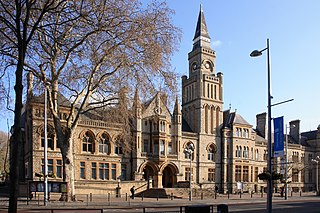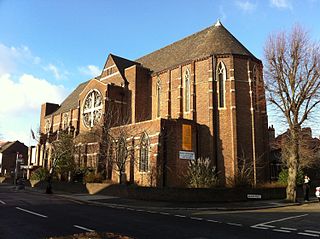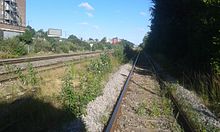
Acton is a town and area in west London, England, within the London Borough of Ealing. It is 6.1 miles (10 km) west of Charing Cross.

Alperton is an area of north west London, England, within the London Borough of Brent. It forms the southern part of the town of Wembley and is 7.5 miles (12 km) west north-west of Charing Cross, on the border with the London Borough of Ealing. It includes a handful of high-rise and many mid-rise buildings as well as streets of low-rise houses with gardens. It adjoins the Grand Union Canal's Paddington Arm, which is fed by the Brent Reservoir.

Harlesden is a district in the London Borough of Brent, North West London.

The London Borough of Ealing is a London borough in London, England. It comprises the districts of Acton, Ealing, Greenford, Hanwell, Northolt, Perivale and Southall. With a population of 367,100 inhabitants, it is the third most populous London borough.

Perivale is an area of Greater London, 9.5 miles (15.3 km) west of Charing Cross. It is the smallest of the seven towns which make up the London Borough of Ealing.

Willesden is an area of north-west London, situated 5 miles (8 km) north-west of Charing Cross. It is historically a parish in the county of Middlesex that was incorporated as the Municipal Borough of Willesden in 1933; it has formed part of the London Borough of Brent in Greater London since 1965. Dollis Hill is also sometimes referred to as being part of Willesden.

Willesden Junction is an interchange station located in Harlesden, north-west London, for London Underground and London Overground services. The station also borders the London Borough of Ealing, near the Old Oak Lane conservation area in the East Acton ward.

Harlesden is a Network Rail station on Acton Lane in northwest London, served by London Overground and by London Underground Bakerloo line trains. The railway line here is the border between the Harlesden and Stonebridge residential area in the east, and the Park Royal industrial estate to the west. The southern end of Willesden Brent Sidings separates the station from the West Coast Main Line.

Hanger Lane is a London Underground station in Hanger Hill, Ealing, on the border between West and Northwest London. It is located on the West Ruislip branch of the Central line, between Perivale and North Acton stations, and is in Travelcard Zone 3.

North Acton is a London Underground station in North Acton, west London in the London Borough of Ealing. The station is on the Central line between East Acton and Hanger Lane on the West Ruislip Branch and West Acton on the Ealing Broadway Branch. It is on the boundary of Travelcard Zone 2 and Zone 3.

North Acton is a part of Acton in west London, and is within the London Borough of Ealing. It runs adjacent to the industrial district of Park Royal. Historically part of the Municipal Borough of Acton in the county of Middlesex, it has formed part of the London Borough of Ealing since 1965.

Old Oak Common (OOC) is a railway station under construction on the site of the Old Oak Common traction maintenance depot to the west of London in Old Oak Common, approximately 500 m (1,600 ft) south of Willesden Junction station. When built, it is expected to be one of the largest rail hubs in London, at about 800 m (2,600 ft) in length and 20 m (66 ft) below surface level.

The Dudding Hill Line is a railway line in west and north-west London running from Acton to Cricklewood. It is roughly 4 miles (6.4 km) long, with a 30 miles per hour (48 km/h) speed limit, and semaphore signalling. The line has no scheduled passenger service, no stations, and is not electrified. It is lightly used by freight trains and, very occasionally, passenger charter trains.
West Twyford is a small residential area forming a northeastern corner of the London Borough of Ealing directly northeast of Hanger Lane station and north of Park Royal, south of the London Borough of Brent and the River Brent. It was historically an extra-parochial area, then civil parish (1866-1926), in Middlesex, England.

The Acton–Northolt line (ANL), historically known as the New North main line (NNML), is a railway line in West London, England. Built between 1903 and 1906, it runs from the Great Western Main Line at Old Oak Common TMD to the Chiltern Main Line at South Ruislip, alongside the West Ruislip branch of the London Underground Central line, for a distance of around 11 miles (18 km).

Hanger Hill or Haymills Estate is a local area and ward of the London Borough of Ealing around Hanger Lane. It was developed in the interwar period when affluent Londoners began to move out of Central London for more green spaces. The estate features spacious houses and flats designed by architects Douglas Smith and Barley.
The North and West London Light Railway (NWLLR), formerly known as the Brent Cross Railway, was a proposal for a light rail system in North and West London in the UK. It was put forward by the London group of the Campaign for Better Transport and by the Coalition for a Sustainable Brent Cross Cricklewood.

The West London Orbital is a proposed extension to the London Overground railway system. The extension would make use of a combination of existing freight and passenger lines including the Dudding Hill Line, North London Line and Hounslow Loop. The route would run for approximately 11 miles (17 km) from West Hampstead and Hendon at the northern end to Hounslow at the western end via Brent Cross West, Neasden, Harlesden, Old Oak Common, South Acton and Brentford.

College Park is a small mainly residential neighbourhood in Kensal Green, to the north of the borough of Hammersmith and Fulham, London and is near Kensal Green station and Willesden Junction station. It borders the London Borough of Brent to the north and the Royal Borough of Kensington and Chelsea to the east. It is part of College Park & Old Oak wards of the United Kingdom.

The Old Oak and Park Royal Development Corporation (OPDC) is a mayoral development corporation established in April 2015 by the Mayor of London.































